![2026 Market Outlook [PODCAST]](/content/dam/thrivent/fp/fp-insights/advisors-market360-podcast/advisors-market360-podcast-16x9-branding-insights-card.jpg/_jcr_content/renditions/cq5dam.web.1280.1280.jpeg)
2026 Market Outlook [PODCAST]
The markets were strong in 2025. Will this momentum continue through 2026?
The markets were strong in 2025. Will this momentum continue through 2026?
12/16/2025
MAY 2025 MARKET UPDATE
05/07/2025

Investors may want to consider rotating from cash to Treasuries and/or corporate bonds.
Thrivent Asset Management contributors to this report: John Groton, Jr., CFA, director of administration and materials & energy research; Matthew Finn, CFA, head of equity mutual funds; and Charles Hofstrom, CFA, investment product manager
The economy is weakening, but data is very short-term right now.
High-quality credit and equities in the large-cap sector are recommended.
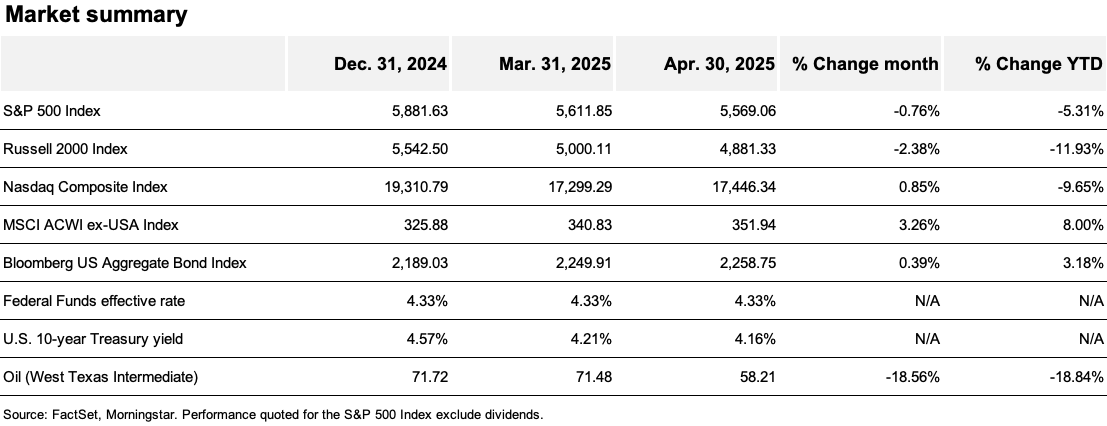
The economy: Economic data released over the month was mixed but generally indicated the U.S. economy was slowing. First quarter gross domestic product (GDP) was modestly negative due to a surge of imports as businesses rushed to get ahead of tariffs. While imports detracted from growth under GDP accounting, the core of the domestic economy remained solid fueled by better-than-expected consumption. Consumers kept spending despite consumer and business confidence weakening, with the former plunging to its lowest level since COVID-19, and domestic manufacturing showed a larger-than-expected slowdown. However, retail sales in March were strong as buyers tried to get ahead of expected tariffs, April’s employment report revealed strong job growth and inflation remained contained.
Stocks: The S&P 500® Index ended April down 0.76% despite a month of extreme volatility as uncertainty about the level and impact of tariffs created concern about the outlook for economic growth and inflation. Equity markets sold off sharply after the April 2 tariff announcements, and market volatility spiked to levels not seen since COVID-19. But the 90-day pause on the bulk of the announced tariffs restored some calm to markets, while evidence of stable inflation and strong earnings from some of the larger technology companies restored optimism.
Bonds: The benchmark U.S. 10-year Treasury note had a particularly volatile month as concern grew about trade policy denting international confidence in U.S. Treasuries as a safe haven from volatile markets. The 10-year yield reached a peak near 4.6%, before falling to close the month at 4.16%, a 0.05% decline from its 4.21% yield at the end of March. Corporate bonds also ended the month relatively unchanged despite seeing significantly wider credit spreads (the yield paid over comparable U.S. Treasuries) mid month. The Bloomberg U.S. Aggregate Bond Index rose 0.39% in April, bringing its year-to-date gain to 3.18%.
The economy: The economy is slowing but we caution investors against over extrapolating long-term trends from short-term data. The past month contained a lot of economic and political headlines that created uncertainty and thus market volatility. While the current levels of tariffs—the highest since at least the Great Depression—are likely to impact growth and inflation, we understand negotiations with trading partners are underway and expect it will take time to hammer out terms acceptable to both sides. In the meantime, falling business and consumer confidence remains a concern, though relatively stable employment and stable inflation data should provide support. We are watching the labor market closely, as the job market is the key to the economy and a meaningful increase in unemployment would be concerning. With a longer-term view, we remain confident that the U.S. economy—bolstered by its dynamism and diversity—will adapt and thrive.
Stocks: We maintain a modest overweight to equities over fixed income given our structurally positive long-term outlook for the economy and we have a bias toward prioritizing economic fundamentals and corporate earnings as the primary determinate of investment returns over the long term. But we caution that shorter-term volatility is likely to persist, whether due to ongoing policy uncertainty or the volatility in economic data which comes with turning points in the economy. While volatility can be concerning, it’s important to note that in periods of uncertainty markets can move up just as fast as they fall. For instance, after a series of sharp declines, on April 9 the S&P 500 Index rose 9.4%—one of its largest one-day rallies in the last century. Staying invested in the market can be challenging, but reducing exposure in periods of high volatility can risk missing substantial upside in a recovery.
Bonds: The outlook for Treasury yields is complicated by the high levels of uncertainty around expected economic growth and the path of inflation. Additionally, April’s extreme volatility prompted questions about the long-term effect trade policy may have on the attractiveness of U.S. Treasuries and a renewed focus on the government’s fiscal outlook. As such, we expect Treasury yields to remain volatile until the outlooks for trade, the economy and inflation become clearer. While Treasuries have long had a stabilizing effect on diversified stock and bond portfolios, we caution that continued volatility may dimmish that effect.
U.S. GDP was negative (-0.3%) in the first quarter of 2025, the first quarter of negative growth in three years. The figure was below consensus expectations for a 0.3% growth rate and well below the average quarterly growth of 3.0% seen in the past few years. A temporary surge in imports weighed on the net exports component of GDP during the period, but other economic data showed signs of softness. For example, the Institute for Supply Management (ISM) Manufacturing Index showed U.S. manufacturing experienced its largest contraction since 2020. The ISM Services Index for April, however, came in stronger than expected as the data continues to be mixed. Overall, the outlook remains cloudy as the scope and level of tariffs is unclear, and the impact of any tariffs has yet to be felt.
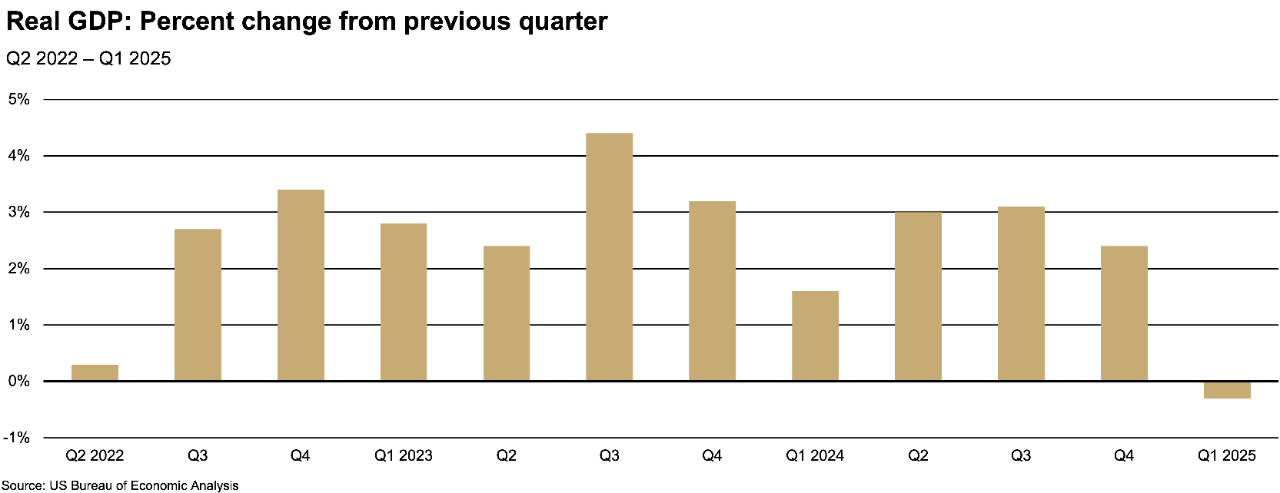
The University of Michigan’s Consumer Sentiment Index fell for another month to its lowest level since the COVID-19 pandemic. Expectations for the next six months are particularly weak, reaching its lowest level in nearly 15 years. However, retail sales rose 1.4% between February and March and rose 4.6% from March of last year. While the rise was the largest monthly gain in two years, it was attributed to spending ahead of expected tariffs.
April’s employment report showed 177,000 new jobs were created during the month, above consensus expectations closer to 133,000 new jobs. Transportation and warehousing employees saw particularly strong job growth, likely in response to the significant boost in imports. In contrast, jobs with the federal government fell by 9,000 over the period, reflecting the current administration’s goal of cutting government spending.
New jobs added in March were revised down from the initial estimate near 228,000 to 185,000.
The national unemployment rate was unchanged at 4.2%, but the share of people unemployed for at least 27 weeks rose, as did the median unemployment duration, which rose to 10.4 weeks. Average hourly earnings rose just 0.17%, below consensus expectations closer to 0.3%.
April’s month-on-month Consumer Price Index (CPI) fell 0.1% —the first decline in headline inflation since 2020. But this was largely driven by the sharp drop in energy prices (down 2.4%) over the period. Core CPI (which excludes the more volatile food and energy sectors) rose 0.1% on the month and 2.8% relative to April of last year. Both figures were below consensus expectations, at 0.3% and 3.0%, respectively.
April’s Core Personal Consumption Expenditures (PCE) Price Index data, which is the Fed’s preferred inflation measure, was more encouraging. Month-on-month, Core PCE was unchanged for the first time in almost a year, while the year-on-year rise of 2.6% was in line with consensus expectations.
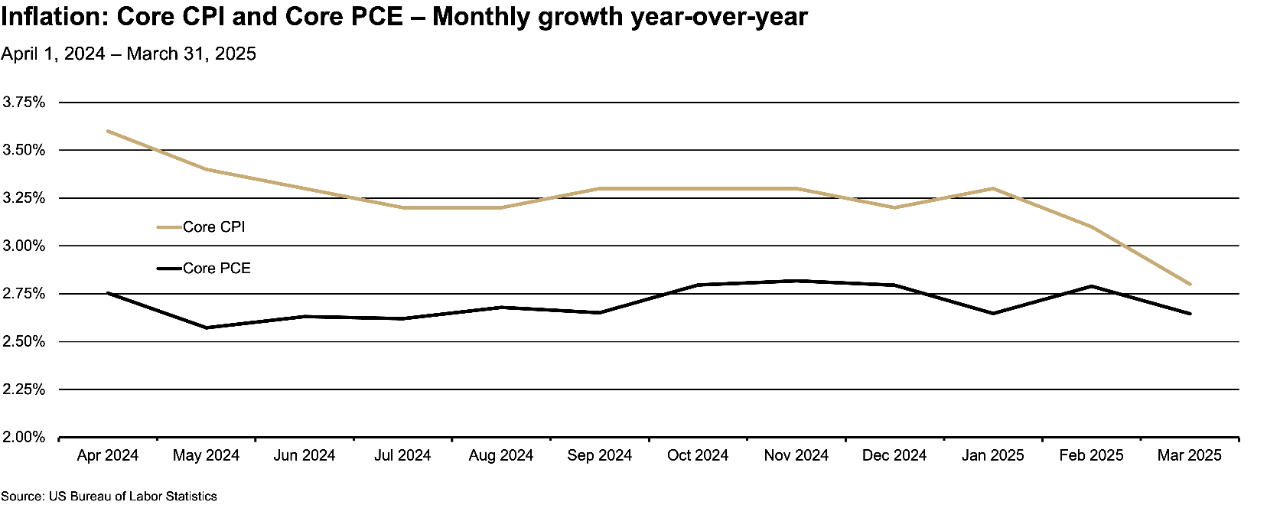
RELATED ARTICLES
Uncertainty is causing market volatility in early 2025, and we expect it will take time for factors causing the uncertainty to settle down.
Bear or near-bear market troughs
Download the Bull & Bear markets PDF to help guide your client discussions about ever-changing markets.
The benchmark S&P 500 Index of large-cap stocks fell 0.68% in April, but this modest decline masks significant intra-month volatility—reaching levels not seen since the COVID-19 pandemic. U.S. stocks found support after the bulk of the announced tariffs were paused and they continued to climb on the back of favorable earnings and supportive inflation data.
The benchmark Russell 2000 Index of small-cap stocks fell 2.38% in April as concerns about the outlook for economic growth weighed particularly heavy on smaller companies. The technology-heavy NASDAQ Composite Index® rose 0.85% over the month, helped by supportive earnings reports.
Within the S&P 500 Index, sector performance was mixed, with information technology and consumer staples showing the strongest returns while the energy sector dropped 13.65% over the month on the back of lower oil prices.
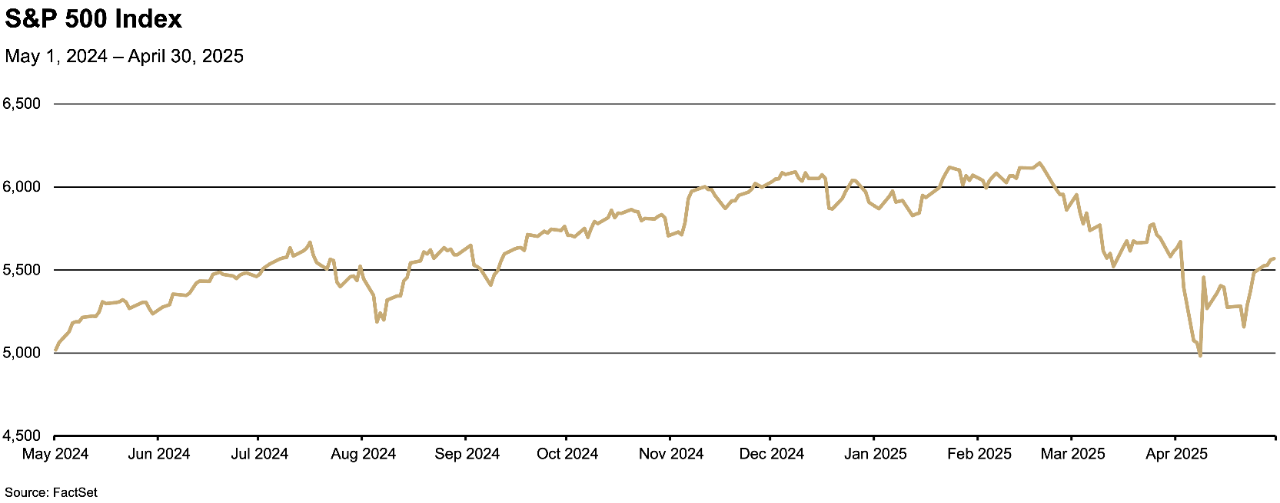
The table below shows the past month and year-to-date performance results of the 11 sectors:
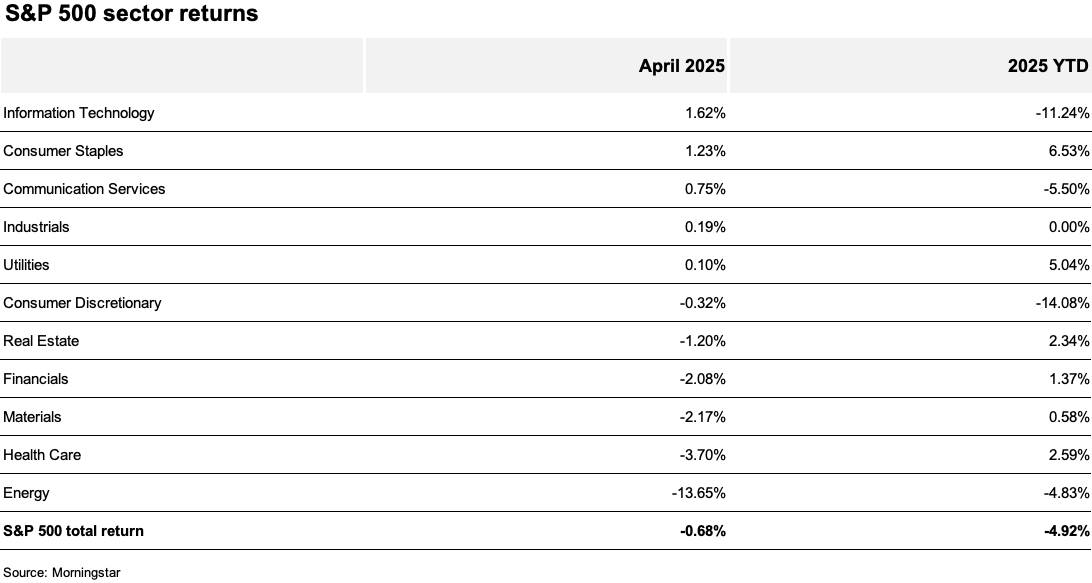
The MSCI ACWI ex-USA Index, which tracks stocks across developed and emerging-market economies across the world (excluding the U.S.) followed U.S. stocks lower in early April but recovered more rapidly and ended the month with a 3.26% gain, bringing its year-to-date return to 8.00%. Expectations for lower interest rates and greater government spending boosting the economy in Europe led the Index higher, while emerging-market equities benefited from a perception that they are less likely to be impacted by U.S. tariffs.
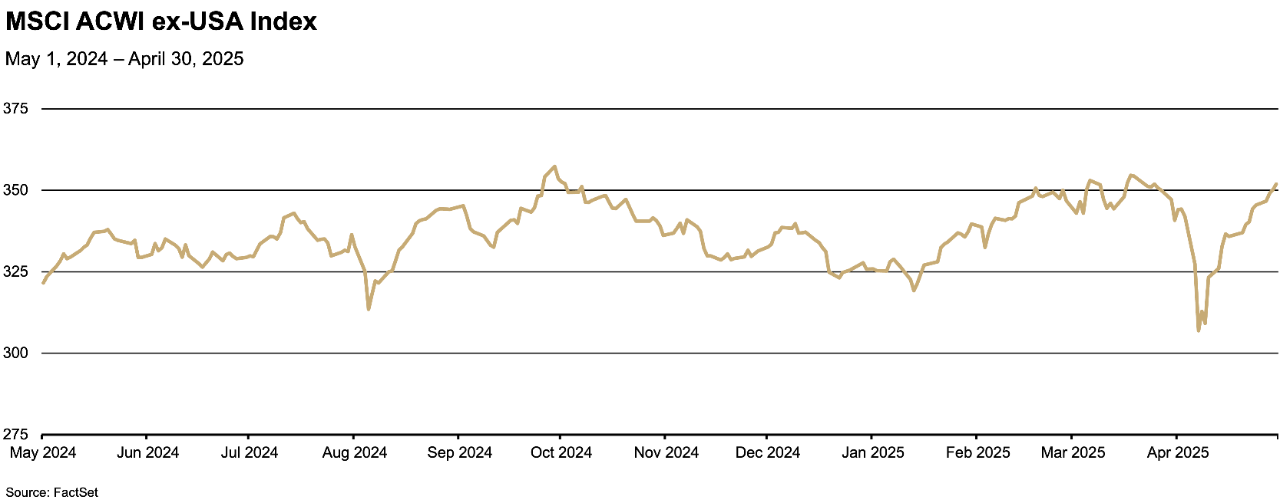
10-year Treasury yields saw their largest weekly rise in a quarter of a century after the April 2 tariff announcements sparked concern about the outlook for economic growth, inflation and the relative attractiveness of Treasury securities amid a falling U.S. dollar. 10-year yields reached an intraday peak near 4.6% before falling back to end the month at 4.16%, a 0.05% decline from the 4.21% yield at the end of March.
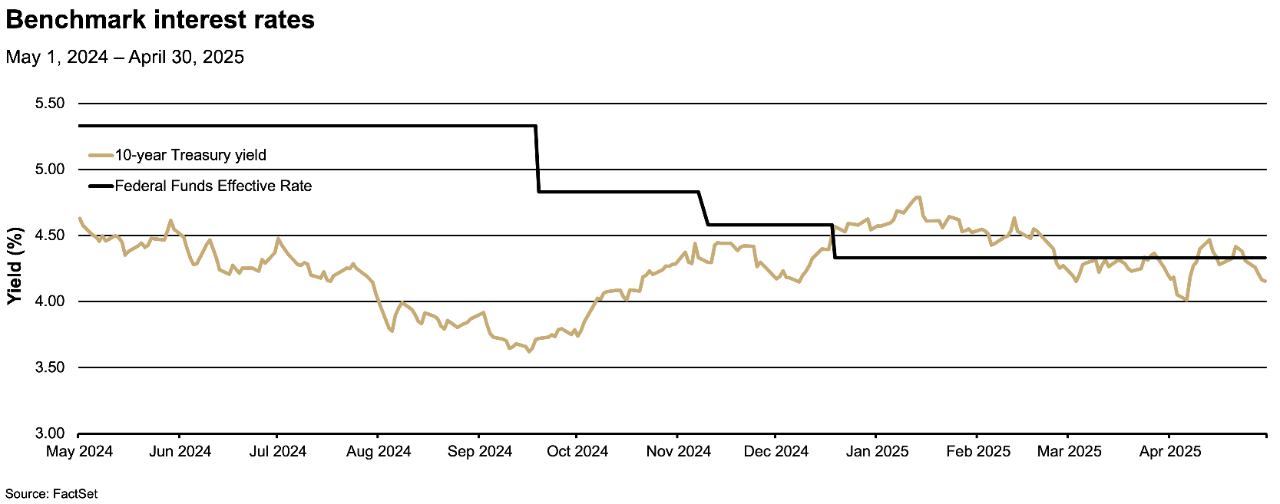
Investment grade corporate bonds ended the month relatively unchanged, with the Bloomberg U.S. Corporate Bond Index down 0.03% in April, bringing its year-to-date return to 2.27%. Yield spreads widened early in the month on trade uncertainty but recovered in tandem with the rebound in U.S. stocks.
High-yield (sub-investment grade) corporate bonds were also essentially unchanged over the month, down 0.02%, lowering their year-to-date return to 0.98%. The Bloomberg U.S. Aggregate Bond Index rose 0.39% in April, bringing its year-to-date gain to 3.18%.
The Nominal Trade-Weighted U.S. Dollar Index fell 2.91% in April, extending its year-to-date decline to -4.82%, largely due to heightened policy uncertainty in the world’s largest economy causing some global investors to rotate out of U.S. dollar assets. The euro continued to be supported by expectations for stronger growth on the back of subdued inflation and lower interest rates, while the yen continued to strengthen on expectations for rising interest rates in Japan.
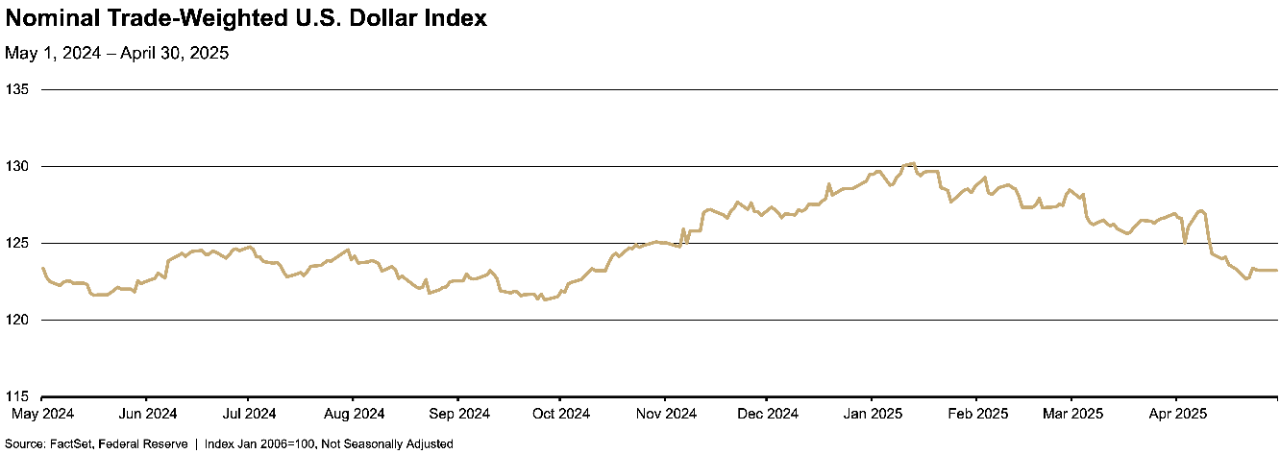
The S&P GSCI Index (a broad-based and production-weighted index representing the global commodity market) dropped 8.79% in April, bringing its year-to-date loss to -5.73%. Oil prices were down sharply on concern about the economic outlook, with a barrel of West Texas Intermediate (a grade of crude oil used as a benchmark in oil pricing) falling 18.56% over the month. The price of gold continued to rise—reaching a new high of $3,500 on April 22—fueled by global central bank demand and concerns about inflation.
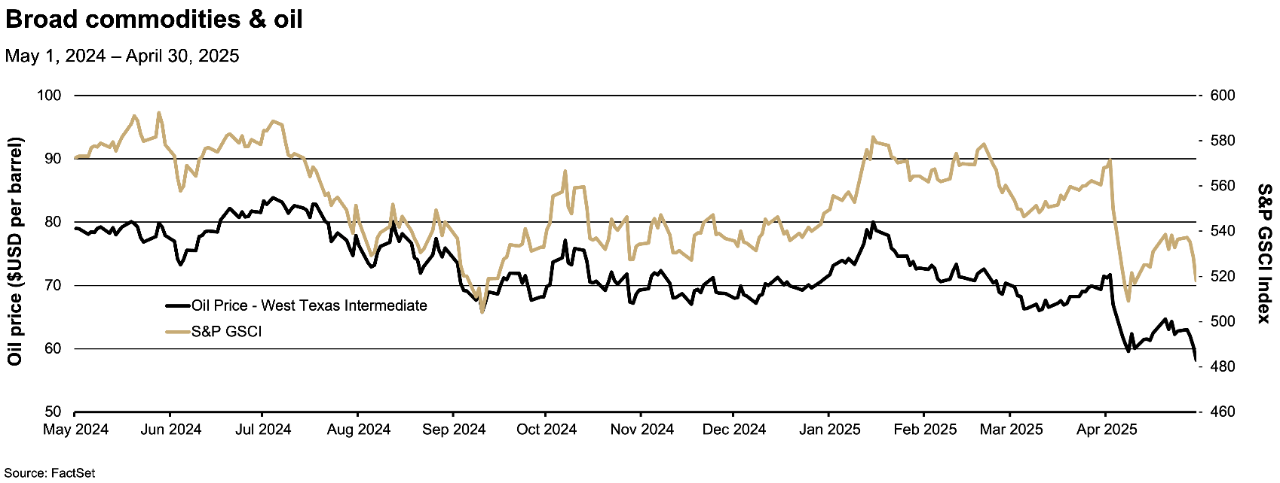
Media contact: Callie Briese, 612-844-7340; callie.briese@thrivent.com
All information and representations herein are as of 05/07/2025, unless otherwise noted.
The views expressed are as of the date given, may change as market or other conditions change, and may differ from views expressed by other Thrivent Asset Management, LLC associates. Actual investment decisions made by Thrivent Asset Management, LLC will not necessarily reflect the views expressed. This information should not be considered investment advice or a recommendation of any particular security, strategy or product. Investment decisions should always be made based on an investor's specific financial needs, objectives, goals, time horizon, and risk tolerance.
This article refers to specific securities which Thrivent Mutual Funds may own. A complete listing of the holdings for each of the Thrivent Mutual Funds is available on thriventfunds.com.
The S&P 500® Index is a market-cap weighted index that represents the average performance of a group of 500 large-capitalization stocks.
The Russell 2000® Index is an unmanaged index considered representative of small-cap stocks.
The Nasdaq Composite Index is a stock market index that includes almost all stocks listed on the Nasdaq stock exchange. The Nasdaq – National Association of Securities Dealers Automated Quotations – is an electronic stock exchange with more than 3,300 company listings.
The MSCI ACWI ex-USA Index is an unmanaged index considered representative of large- and mid-cap stocks across developed and emerging markets, excluding the U.S.
The Bloomberg U.S. Aggregate Bond Index is an unmanaged index considered representative of the U.S. investment-grade, fixed-rate bond market.
The Bloomberg U.S. Corporate Bond Index measures the investment grade, fixed-rate, taxable corporate bond market. It includes U.S. dollar-denominated securities publicly issued by U.S. and non-U.S. industrial, utility and financial issuers.
The Federal Funds effective rate is the interest rate at which depository institutions (mainly banks) lend reserve balances to other depository institutions overnight on an uncollateralized basis. In simpler terms, it's the rate banks charge each other for short-term loans to meet their reserve requirements.
The Consumer Confidence Index (CCI) is a survey administered by the Conference Board. The CCI measures what consumers are feeling about their expected financial situation, whether that's optimistic or pessimistic.
The University of Michigan Consumer Sentiment Index is a consumer confidence index published monthly by the University of Michigan.
The Consumer Price Index measures the monthly change in prices paid by U.S. consumers for a basket of goods and services.
The Core Consumer Price Index (CPI) measures changes in the prices of goods and services, with the exclusion of food and energy.
The Personal Consumption Expenditures (PCE) Price Index, also known as consumer spending, is a measure of the spending on goods and services by people of the U.S.
The Core Personal Consumption Expenditures (PCE) Price Index, also known as consumer spending, is a measure of the spending on goods and services, excluding food and energy prices, by people of the U.S.
The Nominal Trade-weighted U.S. Dollar Index measures the value of the U.S. dollar based on its competitiveness versus trading partners.
The Institute for Supply Management (ISM) Manufacturing Index is a monthly indicator of U.S. economic activity based on a survey of purchasing managers at manufacturing firms nationwide.
The Institute for Supply Management (ISM) Services Index is a monthly indicator of U.S. economic activity based on a survey of purchasing managers at service-based companies nationwide.
Any indexes shown are unmanaged and do not reflect the typical costs of investing. Investors cannot invest directly in an index.
Past performance is not necessarily indicative of future results.